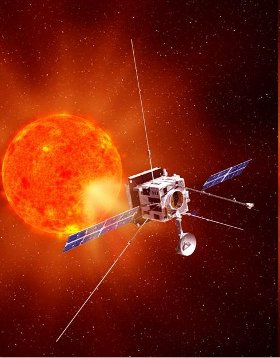|
Solar-Orbiter
High-Resolution Mission to the Sun and Inner Heliosphere addressing the Sun-Heliosphere and Sun-Earth connections.
 The scientific rationale of the Solar Orbiter (SO) is to provide, at high spatial and temporal resolution, multi-wavelength observations of the solar atmosphere and comprehensive in-situ measurements of the unexplored inner heliosphere. By approaching the Sun as close as 58 solar radii, Solar Orbiter will view and diagnose the solar atmosphere with high spatial resolution and combine this with measurements of particles and fields made in-situ. Over its extended mission periods the Solar Orbiter will move out of the ecliptic plane to deliver images and related data that will cover the polar regions of the Sun. By its payload complement, Solar Orbiter will investigate the key topic of heliophysics: How does the Sun create and control the heliosphere?
The scientific rationale of the Solar Orbiter (SO) is to provide, at high spatial and temporal resolution, multi-wavelength observations of the solar atmosphere and comprehensive in-situ measurements of the unexplored inner heliosphere. By approaching the Sun as close as 58 solar radii, Solar Orbiter will view and diagnose the solar atmosphere with high spatial resolution and combine this with measurements of particles and fields made in-situ. Over its extended mission periods the Solar Orbiter will move out of the ecliptic plane to deliver images and related data that will cover the polar regions of the Sun. By its payload complement, Solar Orbiter will investigate the key topic of heliophysics: How does the Sun create and control the heliosphere?
Science objectives
The four main scientific questions addressed by the Solar Orbiter mission are:
-
How and where do the solar wind plasma and magnetic field originate in the corona?
-
How do solar transients drive heliospheric variability?
-
How do solar eruptions produce energetic particle radiation that fills the heliosphere?
-
How does the solar dynamo work and drive connections between the Sun and the heliosphere?
![[Top]](/images/icons/top.gif)
Instrument and Measurements
A selection of 10 instruments has been made for the scientific payload of the Solar Orbiter mission. This comprehensive suite of instruments will support multiple scientific investigations ranging from near-Sun and out-of-ecliptic in-situ measurements to remote-sensing observations of the Sun and its environment:
| Instrument |
Measurements |
| SWA: Solar Wind Plasma Analyser [partly funded by NASA] |
Solar wind ion and electron bulk properties, ion composition |
| EPD: Energetic Particle Detector [partly funded by NASA] |
Composition, timing, and distribution functions of suprathermal and energetic particles |
| MAG: Magnetometer |
DC vector magnetic fields (0 – 64 Hz) |
| RPW: Radio and Plasma Waves |
AC electric and magnetic fields |
| PHI: Visible Imager & Magnetograph (VIM) |
Vector magnetic field and line-of-sight velocity in the photosphere |
| EUI: Extreme Ultraviolet Imager |
Full-disk EUV and high-resolution EUV and Lyman-a imaging of the solar atmosphere |
| SPICE: EUV Spectrometer (EUS) [mainly funded by NASA] |
EUV spectroscopy of the solar disk and the corona |
| STIX: X-ray Imager |
Solar thermal and non-thermal X-ray emission |
| METIS: Coronagraph |
Visible, UV and EUV imaging of the solar corona |
| HI: Heliospheric Imager [mainly funded by NASA] |
White-light imaging of the extended corona |
The MPS largely contributes to the mission’s payload, with a Principal Investigator team to PHI, with a Co-PI team to EUI and with Co-investigator teams to SPICE, METIS, MAG, and SWA.
Planned Launch: Solar Orbiter is now included in ESA’s Cosmic Vision programme and, upon selection, its launch is foreseen in 2017 with an American rocket provided by NASA.
![[Top]](/images/icons/top.gif)
Related links
![[Top]](/images/icons/top.gif)
|
